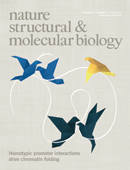Advertisement |
 |
npj Molecular Phenomics is an online-only, open access journal that provides a forum for cutting-edge scientific advances in the emerging field of phenomics, the study of the physical and chemical characteristics of an individual in quantitative terms. Part of the Nature Partner Journals series, npj Molecular Phenomics is published in partnership with Fudan University.
The journal is now open for submissions.
Find out more >>> |  | |
 |
 |
TABLE OF CONTENTS
|
June 2017 Volume 24, Issue 6 |
 |  |  |
 |  Meeting Report Meeting Report
 News and Views News and Views
 Perspective Perspective
 Articles Articles
 Erratum Erratum
 Corrigendum Corrigendum |  | Advertisement |  Collection: On Growth and Form Centenary Collection: On Growth and Form Centenary
Join Nature in celebrating the centenary of D'Arcy Wentworth Thompson's seminal publication "On Growth and Form". We present an online collection of research and comment reflecting the diversity of explorative activity across the physical and biological sciences over the past 100 years.
Access the On Growth and Form Centenary Collection | |
|
|
 |
|
 |
 |
Advertisement |
 |
|
 |
| |
| Advertisement |
 |
| |
 |
| |
Meeting Report |  Top Top |
 |
 |
 |
Gathering by the Red Sea highlights links between environment and epigenetics pp491 - 493
Mo Li, Emiliana Borrelli, Pierre J Magistretti, Juan Carlos Izpisua Belmonte, Paolo Sassone-Corsi et al.
doi:10.1038/nsmb.3422
The number of conferences on epigenetics has been increasing in the past decade, underscoring the impact of the field on a variety of areas in biology and medicine. However, the mechanistic role of the epigenome in adaptation and inheritance, and how the environment may impinge on epigenetic control, are topics of growing debate. Those themes were the focus of the inaugural international King Abdullah University of Science and Technology (KAUST) Research Conference on Environmental Epigenetics in Saudi Arabia, where more than 100 participants from 19 countries enjoyed vibrant scientific discussions and a pleasant February breeze from the Red Sea. |
 |
News and Views |  Top Top |
 |
 |
 |
|
 |
Perspective |  Top Top |
 |
 |
 |
DNA N6-methyladenine in metazoans: functional epigenetic mark or bystander? pp503 - 506
Guan-Zheng Luo and Chuan He
doi:10.1038/nsmb.3412
The DNA-adenine modification 6mA has recently been identified in metazoans. This Perspective summarizes the latest discoveries and suggests potential functional roles for 6mA in metazoan genomes. |
 |
| Advertisement |
 |
nature.com webcasts
Springer Nature presents a custom webcast by Professor Aude Chapuis, MD on harnessing the therapeutic potential of adoptively transferred cells.
Register for FREE
Date: Thursday, June 22 2017
Time: 11AM PDT | 2PM EDT Register
Sponsored by:
10x Genomics |  | |
 |
| |
Articles |  Top Top |
 |
 |
 |
Human CTP synthase filament structure reveals the active enzyme conformation pp507 - 514
Eric M Lynch, Derrick R Hicks, Matthew Shepherd, James A Endrizzi, Allison Maker et al.
doi:10.1038/nsmb.3407
The human enzyme CTP synthase forms polymeric filaments with increased catalytic activity, in contrast to the inactive filaments formed by bacterial CTP synthase. Cryo-EM and crystallographic analyses explain the structural bases for those different behaviors. |
 |
 |
 |
Active and poised promoter states drive folding of the extended HoxB locus in mouse embryonic stem cells pp515 - 524
Mariano Barbieri, Sheila Q Xie, Elena Torlai Triglia, Andrea M Chiariello, Simona Bianco et al.
doi:10.1038/nsmb.3402
Homotypic interactions between active and Polycomb-repressed promoters co-occurring in the same DNA fiber, rather than CTCF occupancy, explain the 3D HoxB folding pattern.
See also: News and Views by Sanyal et al. |
 |
 |
 |
The myosin mesa and the basis of hypercontractility caused by hypertrophic cardiomyopathy mutations pp525 - 533
Suman Nag, Darshan V Trivedi, Saswata S Sarkar, Arjun S Adhikari, Margaret S Sunitha et al.
doi:10.1038/nsmb.3408
A working model for β-cardiac myosin in the sequestered state and binding assays reveal interactions between the myosin head and tail that are disrupted by mutations associated with hypertrophic cardiomyopathy. |
 |
 |
 |
ADAR1 controls apoptosis of stressed cells by inhibiting Staufen1-mediated mRNA decay pp534 - 543
Masayuki Sakurai, Yusuke Shiromoto, Hiromitsu Ota, Chunzi Song, Andrew V Kossenkov et al.
doi:10.1038/nsmb.3403
In stressed cells, the ADAR1p110 isoform is phosphorylated and translocated from the nucleus to the cytoplasm, where it protects transcripts with 3′-UTR dsRNA structures from Staufen1-mediated decay, thus suppressing cellular apoptosis.
See also: News and Views by Elbarbary & Maquat |
 |
 |
 |
5-Formylcytosine does not change the global structure of DNA pp544 - 552
Jack S Hardwick, Denis Ptchelkine, Afaf H El-Sagheer, Ian Tear, Daniel Singleton et al.
doi:10.1038/nsmb.3411
X-ray crystallography and NMR analysis demonstrate that, contrary to previous observations, fC does not significantly alter DNA structure, thus suggesting an alternative basis for recognition of fC-DNA by epigenome-modifying enzymes. |
 |
| Advertisement |
 |
| |
 |
| |
Erratum |  Top Top |
 |
 |
 |
Erratum: Molecular basis of telomere dysfunction in human genetic diseases p553
Grzegorz Sarek, Paulina Marzec, Pol Margalef and Simon J Boulton
doi:10.1038/nsmb0617-553a |
 |
 Top Top |
 |
 |
Corrigendum |  Top Top |
 |
 |
 |
Corrigendum: Quaternary contact in the initial interaction of CD4 with the HIV-1 envelope trimer p553
Qingbo Liu, Priyamvada Acharya, Michael A Dolan, Peng Zhang, Christina Guzzo et al.
doi:10.1038/nsmb0617-553b |
 |
 |  |  |  |  |  | Natureevents is a fully searchable, multi-disciplinary database designed to maximise exposure for events organisers. The contents of the Natureevents Directory are now live. The digital version is available here.
Find the latest scientific conferences, courses, meetings and symposia on natureevents.com. For event advertising opportunities across the Nature Publishing Group portfolio please contact natureevents@nature.com |  |  |  |  |  |
|
 |


No comments:
Post a Comment